14 Ways To Cook Perfect Shrimp
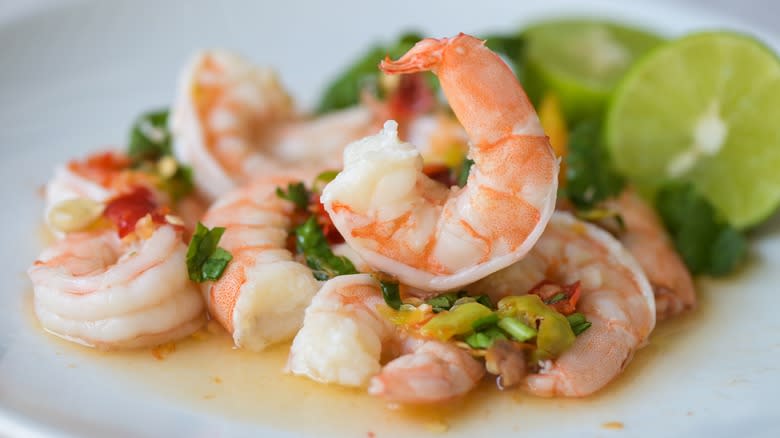
People sure love shrimp. Even folks who aren't the biggest fans of seafood still have a place in their heart for these bite-size crustaceans. It's no wonder, then, that roughly 5.9 pounds of shrimp are eaten per capita in America, according to the National Oceanic and Atmospheric Administration. For many, shrimp is the perfect balance of availability, affordability, and taste. Virtually every supermarket in the country stocks it, it doesn't break the bank to buy, and it has a mild, buttery taste that isn't too briny, making it compatible with a wide variety of seasonings and flavors.
If we had to pinpoint exactly why shrimp is so popular, though, we'd put it down to the fact that it can be cooked virtually any way you want. Like many types of seafood, shrimp cooks quickly -- and yet it retains its juiciness once heated through, meaning it's equally suited to shorter and longer cooking techniques. Additionally, the more ways you learn to cook with shrimp, the more you're able to subtly harness its internal flavors to add rich layers to your food. There's a right and a wrong way to employ each cooking style with shrimp, though. We're here to show you how to do things right.
Read more: 13 Tips To Make Your Shrimp Taste So Much Better
Sautéeing
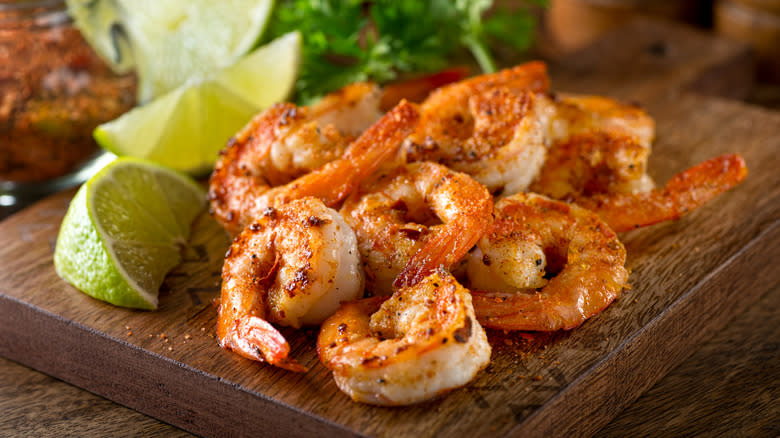
Sautéeing is one of the most popular ways to cook shrimp, and for good reason. This method utilizes dry heat to cook shrimp in a pan, browning them on each side with a small amount of fat. Because sautéeing is done with pretty high heat, it allows you to get a good sear on shrimp quickly without overcooking the interior. Plus, the relatively low fat quantity means that the flavor of the seafood shines through.
Sautéeing also gives you access to a wide variety of flavors to complement your shrimp. If you want to keep things simple, you can add a little salt and pepper to your food, finishing it off with a chunk of butter to bring out the shrimp's slightly creamy flavors. Or, for added sweetness, try sautéed shrimp with pineapple. The natural sugars in the pineapple and its light, floral flavor are a natural fit for shrimp, which has a mildly sweet top note. Throwing garlic, ginger, and red pepper flakes into the mix gives additional layers of flavor, with the ginger and red pepper flakes bringing a touch of gentle heat. A bit of butter at the end brings everything into harmony.
Steaming
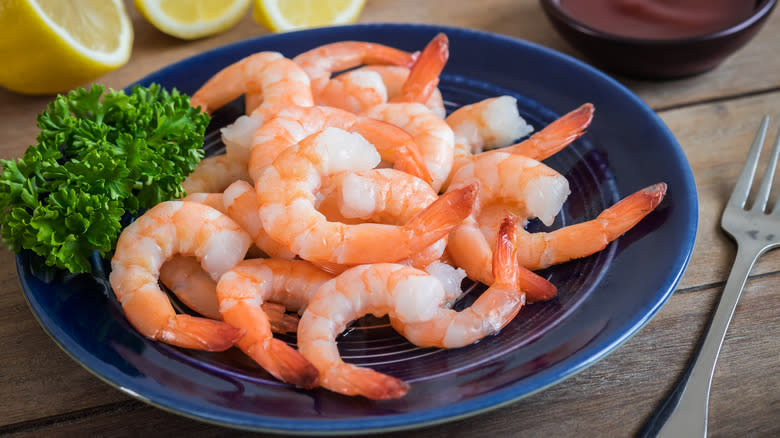
As seafood tends to cook way quicker than other proteins, it's a natural fit for steaming -- and shrimp, with its smaller size, fits the bill perfectly. Steaming shrimp takes mere minutes, and produces a tender, moist result. As it's such a gentle cooking process, steaming shrimp doesn't sap any of its natural juices; they're retained in each bite. This cooking method is also totally fat free and doesn't require any effort at all to do. You just have to throw your shrimp in the steaming basket and wait a few minutes.
Bear in mind, though, that steaming doesn't necessarily add any extra flavor to shrimp during the cooking process. As such, you'll need to either marinate the shrimp beforehand, season them afterward, or imbue flavor via your steaming liquid. For something like Old Bay-steamed shrimp, simultaneously steaming them using a spicy broth and coating them with Old Bay at the end gives them a double punch of complexity and depth. After cooking them this way, the shrimp are flavorful enough to be served without any sauce or dressing.
Poaching
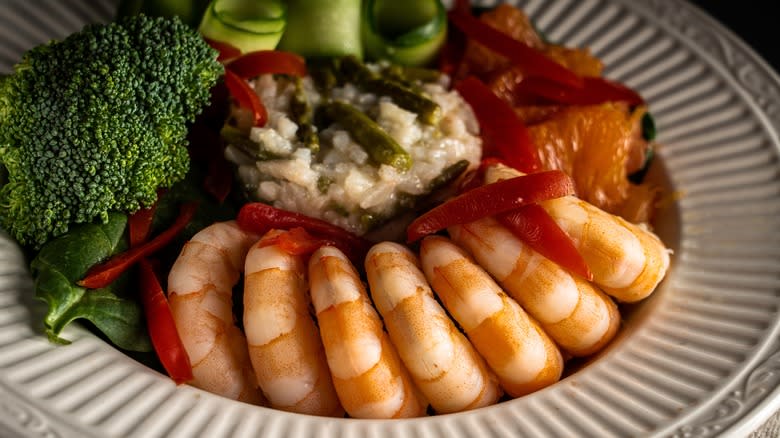
Poaching may not be the most fashionable of cooking methods, but when it comes to shrimp, it's ideal. Poaching is the act of submerging food in barely-simmering liquid until it's cooked, and it's perfect for the quick-cooking nature of this crustacean. You poach shrimp by simply dropping them into the simmering pot; they cook in just a few minutes and stay plump, thanks to the fairly low temperature of the liquid. Poaching is a particularly useful method if you need to cook a big batch of shrimp in one go, or if you're looking to avoid using too many external elements (like oil or butter) in your cooking process.
It's important to remember, though, that your choice of liquid can make a huge difference when poaching shrimp. Using plain water may be convenient, but it's also a missed opportunity to add flavor to your seafood. Instead, you should poach shrimp in as flavorful a broth as you can create, to maximize each bite's deliciousness. Things like herbs, spices, garlic, and onion can add earthy and savory notes to your shrimp, and are easily incorporated into a broth. Remember also that some flavorings can add unexpected depth: Throwing in alcohols like tequila or rum can provide real intensity and slightly caramelized notes.
Grilling
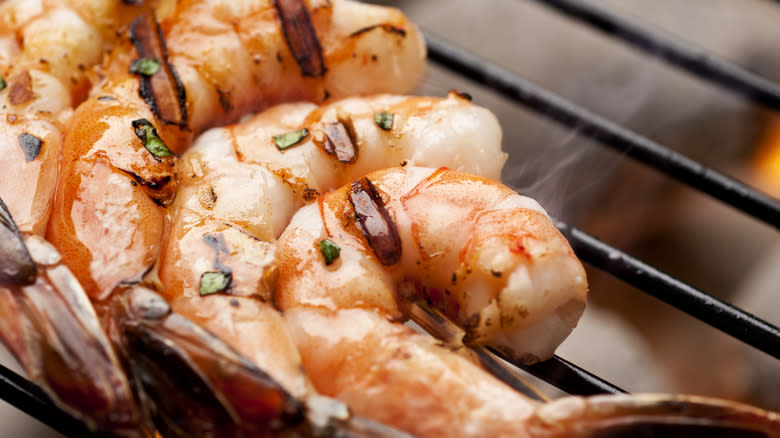
There's a reason why grilled shrimp is so popular: It tastes really, really good. Grilling shrimp develops an excellent char on the outside of your seafood, which increases the shrimp's flavor enormously. This char is created by the Maillard reaction, which browns the proteins and sugars on the outside of the shrimp, creating new, rich flavor compounds. The smokiness of your grill and whether or not you're cooking the shrump over an open flame can also give your dish added flavor. Plus, the high heat used means that the shrimp cooks incredibly quickly.
Like other shrimp cooking methods, grilling takes little time: Just 1 to 2 minutes are required on each side on a hot grill for them to be done. It's important to keep their size in mind, however. Smaller pieces of shrimp can fall through the slats into the open fire below, so make sure you're only grilling larger shrimp, or keeping them attached by skewering them together. It's also worth remembering that while grilled shrimp can be served without any additional adornments, other ingredients can take the meal to the next level. Grilled shrimp cocktail, for example, combines barbecue-infused flavor and decadent creaminess.
Flat-Top Griddling
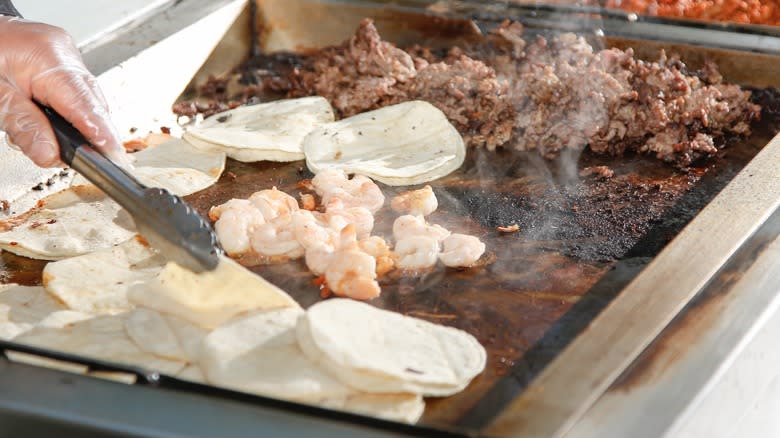
If you have a flat-top griddle, you should be using it to cook your shrimp. Flat-top griddling gives you all the power of a grill without any of the risk of shrimp falling through. What you'll lose in aesthetically pleasing strips of char on your seafood, you'll gain in evenness: A griddle provides a flat bed of consistently high heat, which means your shrimp get fully browned on each side, maximizing their flavor.
To cook shrimp on a flat-top griddle, simply place them on the hot pre-heated surface and allow them to fry for 1 to 2 minutes on each side. While they're cooking, you can work on your other ingredients. Flat-top griddles are particularly good choices for shrimp dishes, as their wide heated surface permits you to cook several different items simultaneously, allowing for complex dishes and saving you clean-up time afterwards. Try making a souvlaki-style grilled shrimp using a flat-top griddle instead of a grill. While your shrimp is cooking, use the other side of the griddle to char some onions and peppers and warm up your flatbreads. Spoon it all onto a big serving platter, and let your guests dig in.
Air Frying
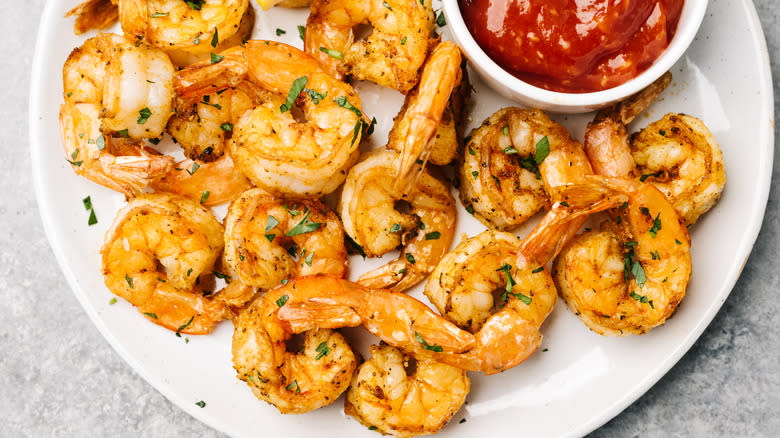
If you have an air fryer, you've likely already cooked shrimp in it -- but if not, you're missing out. Air fryers can cook shrimp in just four minutes when set to 400 degrees Fahrenheit, and when you flip them halfway through, they develop beautiful color on each side. As with most things cooked in an air fryer, the device's small, enclosed cooking compartment is the key to success here. Because the air fryer basket is so petite, it's able to concentrate all the heat generated on the food inside, simultaneously saving energy and increasing flavor. This leads to tremendously tasty shrimp.
Air frying shrimp is also a great way to cook without using too much oil, allowing you to focus on the flavor of the shrimp itself. Having said this, a total absence of fat can lead to dry, mealy shrimp pieces that get stuck to the bottom of your basket, so make sure you use at least a little bit. It's best to add flavor by using a quick coating or marinade so that it can permeate the shrimp's flesh. If you want to keep things plain, though, you can simply air fry shrimp using some basic seasonings, or with a tiny bit of unflavored fat.
Ceviche
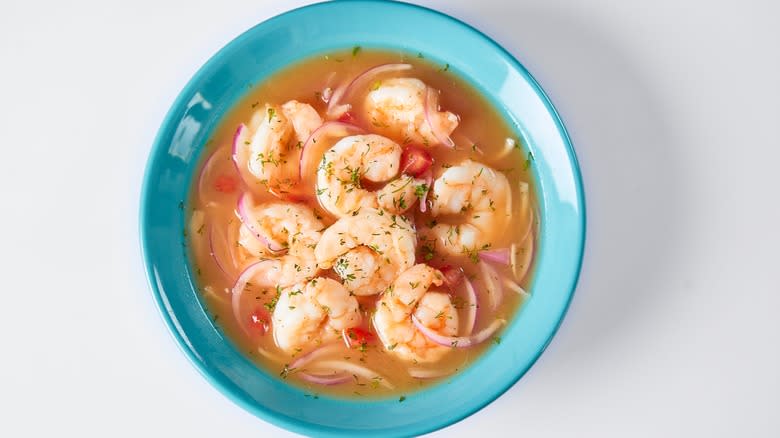
Ceviche is one of the classiest ways to cook and eat seafood. Instead of using heat to prepare the protein, the ceviche process uses the acid in lemon or lime juice to cure raw seafood. When combined with this zesty juice, the fish or shellfish turns white and firm, as if you had steamed or poached it -- but with added flavor from the marinade.
Shrimp ceviche is just as delicious as other types, if not more so -- the citrus that runs through the dish complements the natural flavor of the crustacean enormously well. It's important, though, to remember one key thing: You really shouldn't use raw shrimp to make it. Raw shrimp is particularly prone to containing Vibrio bacteria, which can cause pretty nasty food poisoning or conditions like gastritis or even cholera (per Healthline). Some argue that if your shrimp is especially fresh, using it raw in ceviche isn't a big deal. But it's probably always better to cook your shrimp first, then add the flavorful citrus marinade. Steaming your shrimp beforehand will not only reduce any chance of food poisoning, it will also make it firmer and therefore easier to dice up.
Roasting
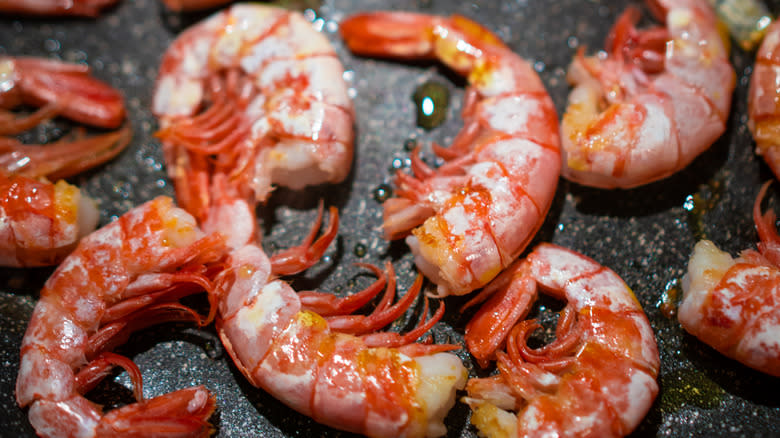
If you want a hands-off and delicious cooking method for your shrimp, roasting's where it's at. Roasting is an excellent way to cook a whole load of shrimp with minimal effort, while also producing seriously intense flavor. Because roasting uses dry, open heat to cook food, it gently activates the Maillard reaction, giving shrimp luscious color and flavor that you just don't achieve with wet heat methods. As a bonus, it also fills up your house with beautiful aromas while your shrimp slowly but surely cooks.
Roasting shrimp takes slightly longer than frying or poaching, but generally, you can cook a batch in around 8 to 10 minutes in a 400 degree Fahrenheit oven. Make sure that you flip your shrimp halfway through your cooking time so that it gets the same heat on both sides. You can roast both peeled and unpeeled shrimp, depending on your preference. If you do choose to peel your shrimp, though, don't throw away the shells. Instead, roast them on their own afterwards before simmering them for 10 to 15 minutes in boiling water, to make a deeply flavorful roasted shrimp stock.
Wok Frying
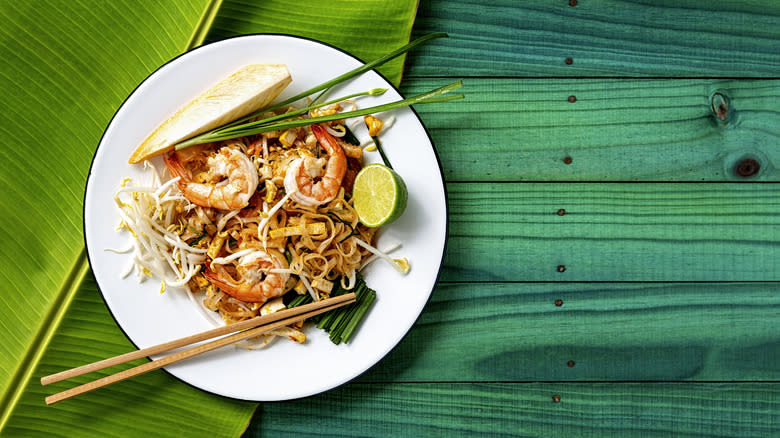
Shrimp is perfectly suited to wok frying, as is proved by the fact that it's found in countless stir-fried dishes around the world. The central premise of wok cooking -- heating food over ultra-high heat to cook it very quickly -- suits shrimp perfectly. By using such intense heat, the shrimp browns fast without overcooking. Plus, their diminutive size means that they incorporate well with other stir-fried ingredients.
When wok frying, it's important to remember that speed is the name of the game. Shrimp tend to become tougher and more rubbery the longer they're heated, so if you keep them in the hot pan for too long, you might find they're soon inedible. As such, when you're making a dish like shrimp pad thai, make sure to add all of your ingredients quickly and only cook for as long as you need to for everything to soften, brown, and warm through. You may also choose to fry your shrimp first before any of the other ingredients, scoop or pour them out of the wok, then cook everything else, adding them back in at the end so that they remain super juicy.
Deep Frying
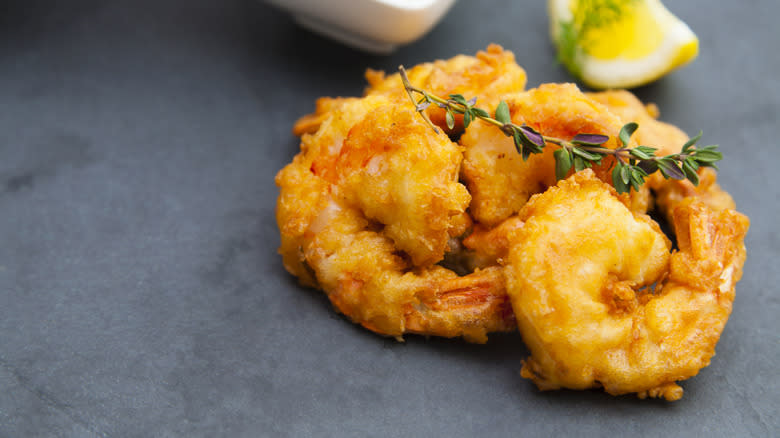
Deep fried shrimp is pretty much universally beloved, and honestly, we get it. Deep frying is a surefire way to lock in shrimp's existing flavor and moisture while adding a huge amount more in just a few minutes. Battering shrimp before throwing it in the deep fryer helps create a barrier around the little morsels that stops moisture from seeping out while they cook, preserving their juiciness. Simultaneously, the added fat gives the seafood a more succulent mouthfeel. The deep frying process also introduces a crunch factor, providing a textural contrast that's hard to achieve with other cooking methods.
When deep frying shrimp, it's usually easier to rely on color instead of time. You should fry the shrimp in 350 degree Fahrenheit oil until your batter is golden brown. As shrimp meat cooks so quickly, you don't have to worry too much about whether it'll be cooked through or not -- the main thing is to make sure you get that deep brown shade on the outside and a crunchy exterior. Once your shrimp is cooked, you can use it in a huge variety of ways. Pop them into a fried shrimp po'boy, serve them on top of a salad, throw them into a basket next to some fries, or enjoy them on their own as an appetizer.
Stewing
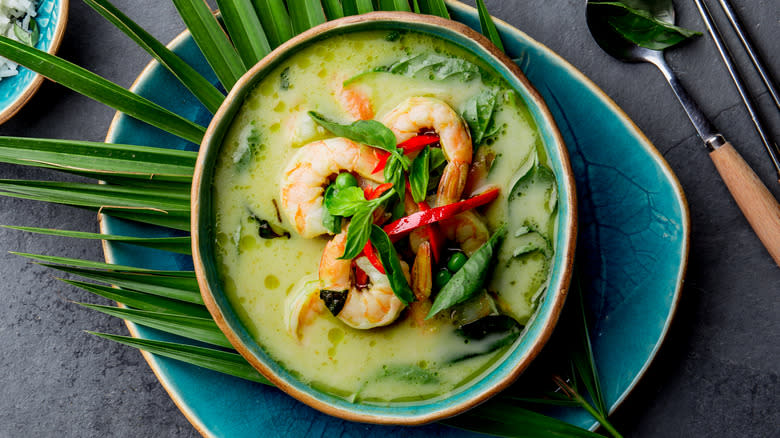
Stewing shrimp is one of the heartiest ways to cook it, as well as one of the most flavorful. By combining shrimp with other ingredients in a broth or sauce and simmering, you keep the seafood juicy while also allowing it to meld with other flavors. Like other wet heat methods, stewing shrimp cooks the juicy little crustaceans quite quickly, so it's usually a good idea to add them near the end of your cooking process -- especially if you're using a recipe that requires a lot of time on the stove.
You should remember, though, that not every stew requires hours of simmering on the cooktop. Shrimp with green curry, for example, is essentially a form of stew that takes just 15 minutes from start to finish. Instead of producing flavor by slow-cooking ingredients together, this dish creates it through the use of super-fragrant curry paste, combined with anchovy paste, brown sugar, and coconut milk. Shrimp are the perfect vehicle for this rich combination of tastes, with their mild flavor working as a counterbalance to the spiciness and saltiness running through it.
Boiling
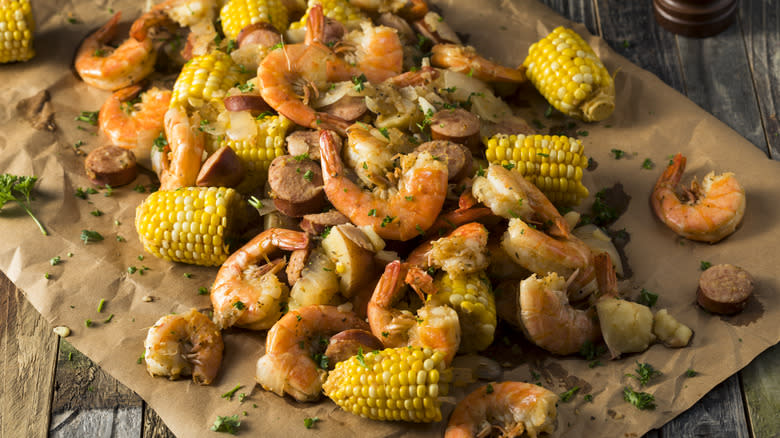
It doesn't get much easier than boiling shrimp. Boiling is the traditional method for many folks in the American South, especially as part of the famous seafood boil. This classic dish developed as a means of feeding big groups through one communal meal; boiling various types of seafood together -- plus potatoes, corn, and other veggies -- is easy and flavorful. When you boil shrimp alongside other ingredients, it takes on all of their flavors and cooks quickly. Plus, it remains moist, thanks to the wet heat.
Of course, if you're not a big fan of other seafood, you can simply make a shrimp boil. This New Orleans recipe gets rid of seafood additions like crab and crawfish and instead centers the shrimp, using spicy link sausage and a range of seasonings to give it a huge dose of flavor. Although shrimp is a central component in this dish, it's important not to add them until the very end, to prevent overcooking. That doesn't mean they'll lack taste, though: As soon as the shrimp enter the cooking broth, they'll take on the flavors of corn, sausage, potatoes, mushrooms, and spices that have been simmering away for almost an hour.
Braising
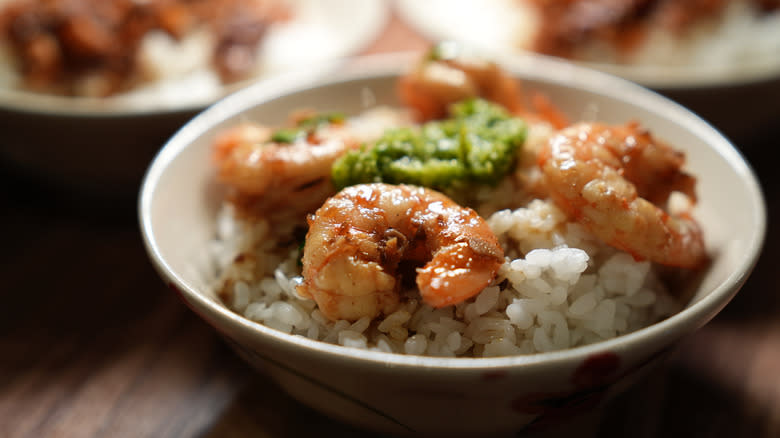
Braising is not one of the most common cooking methods for shrimp, but we think you should give it a try. Braising requires a two-step process: You first pan-sear your chosen central ingredient, then add a stock or alternative cooking liquid and reduce everything to a simmer. Allow your food to cook gently for a long time, which slowly tenderizes it and gives it a deep, rich flavor. This accentuates the caramelization you' achieved through frying your shrimp in the first place.
As everything happens more quickly with seafood, though, you won't require that much cooking time -- especially when compared to something like braised beef. Keep shrimp out of the liquid for as long as possible while adding other ingredients that hold up better to long braising times to give the dish deep, rich flavor.
Many braised shrimp recipes call for searing the shrimp before removing them from the pan. Stock ingredients are then added to the same pan, and brought to a simmer. Other ingredients like lobster or veggies can be thrown in next. Shrimp is added back in to finish things off. While this is a multi-step process, it keeps everything tender, yet flavorful.
Pickling
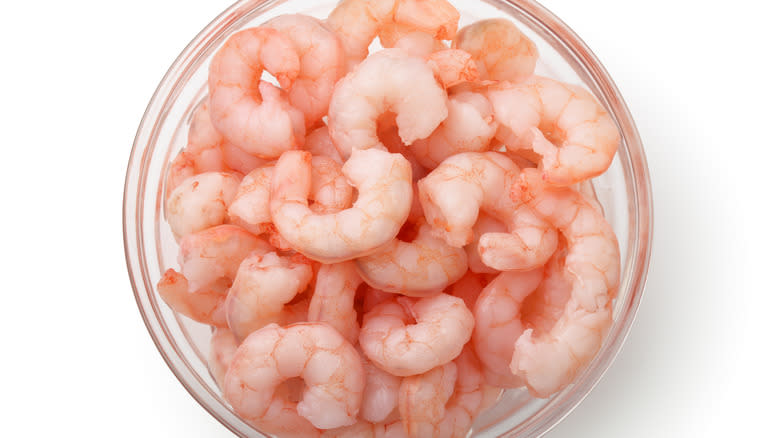
Pickling shrimp might seem a little strange, but once you try it, you won't look back. There's actually a rich tradition of pickling seafood throughout culinary history; it gives extra flavor and preserves the seafood for longer periods of time. Pickling shrimp gives it an especially extraordinary amount of flavor: The sharp vinegar of the pickling liquid serves as an excellent contrast to the mild, somewhat unassuming taste of the shrimp flesh.
Notably, seafood tends to be pickled in vinegar and doesn't require any fermenting, unlike pickling via the use of lactic acid. It's best to make pickled shrimp using cooked shrimp, to avoid any risk posed by bacteria. After you poach or steam the shrimp pieces, simply chop them up and combine them with your pickling liquid before leaving them to sit for 24 hours. During that sitting time, the shrimp will take on the deep, tangy flavors of the vinegar, lemon juice, and seasonings. Take note, though: Pickling shrimp may prolong its lifespan slightly, but it's still not wise to keep it for longer than a week or so. If you notice any strange smells or unpleasant flavors in the pickled shrimp, you should throw it out immediately.
Read the original article on Daily Meal.

